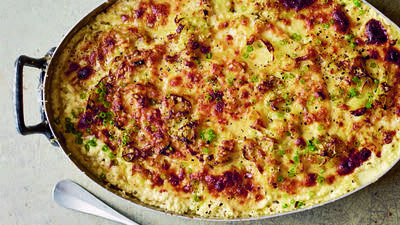Okay, here you are: This is my single favorite go-to, home-cooking, just-us-folks, one-dish meal. I make it all the time —at least once a week, my vast bean (and other) culinary appreciation and repertoire notwithstanding. If, growing tired of coming up with the nightly menu, I say to my companion, "Anything in particular you're in the mood for, David?" I can be pretty sure he'll say, "Well, how about the greens and beans and pasta? We haven't had that in a while." That we actually have had it is irrelevant; it's that good.
Why? It's healthy, bold, flavorful, toothsome, easy, and inexpensive. Its main ingredients are just interchangeable enough to ring small variations on; it never ever gets boring. And, oh yes: It is quicker than quick. Put the water on to boil for the pasta, begin the sauté, and everything's done at the same time. Choose a pasta type that's not too delicate. Go with dried, not fresh; eschew angel hair, thin spaghetti, orzo, or tiny stars. Instead, choose any good semolina or whole wheat pasta of medium size: fusilli, ziti, fettuccine, or shells.
Vegans can omit the cheese in this (perhaps substituting nutritional yeast) and still have a fine dish.
Ingredients
16 ounces dried pasta (see headnote)
2 to 3 whole dried chiles, stemmed and broken in half
3 to 5 tablespoons extra-virgin olive oil
1 large bunch of Swiss chard, rinsed well (but with some moisture still clinging to the leaves), tough ends of stems removed, leaves and tender parts of stems sliced crosswise into 1/4-inch ribbons
3 to 5 cloves garlic, chopped
1 lemon, halved
1 can (15 ounces) chickpeas, drained well
Coarse sea salt
Freshly ground black pepper
Finely grated Parmesan cheese, for serving (omit for vegans)
Instructions
1. Bring a large pot of salted water to a boil and cook the pasta according to the package directions.
2. Meanwhile, set a large, heavy skillet (ideally cast iron) over medium-high heat. Place the chiles in the skillet and toast, stirring them or giving the pan a shake occasionally, until they darken slightly, 1 to 2 minutes. (You might want to turn on an exhaust vent, if you have one, or throw open the windows; the air gets pretty pungent and cough-producing.)
3. Add 2 tablespoons of the olive oil and then, almost immediately, the still-wet greens. Stir. There will be a big sizzle and the greens will quickly start wilting down, deepening in color. Immediately, just as soon as the greens have been stirred into the chile and olive oil, pop a tight-fitting lid over the skillet. Lower the heat just a bit and let the greens steam in their own liquid for 3 to 4 minutes.
4. Lift the lid and stir in the garlic. Cook for a few minutes more, just to take the edge of rawness off the garlic (don't let it brown), stirring to distribute everything. Then turn off the heat, squeeze half the lemon over the greens (squeeze through a strainer, to trap the seeds), and add the beans. Stir some more to heat the beans through (the pan will still be plenty hot). Add coarse sea salt and pepper to taste.
5. When you pasta is done (which might be about now, or midway through lemoning the greens), drain it well. Pile it, steaming hot, onto serving plates and divide the greens and beans over each portion. You can try to pick out the chiles if you like, or warn diners that they are there (if you're using red-stemmed chard, it's quite hard to spot those chiles, so, I repeat, warn those who like their food tamer). Drizzle each portion with a bit of the remaining olive oil. Cut the remaining lemon half into wedges, and pass them along with the Parmesan at the table.
From Bean by Bean: A Cookbook by Crescent Dragonwagon (Workman Publishing, 2012). Copyright © 2012 by Crescent Dragonwagon. All rights reserved. Used with permission of Workman Publishing.
Before you go...
Each week, The Splendid Table brings you stories that expand your world view, inspire you to try something new, and show how food connects us all. We rely on your generous support. For as little as $5 a month, you can have a lasting impact on The Splendid Table. And, when you donate, you’ll join a community of like-minded individuals who love good food, good conversation, and kitchen companionship. Show your love for The Splendid Table with a gift today.
Thank you for your support.
Donate today for as little as $5.00 a month. Your gift only takes a few minutes and has a lasting impact on The Splendid Table and you'll be welcomed into The Splendid Table Co-op.




